Gugu-Badhun, Yirandali, Kalkadoon, Waanyi, and Mayi-Thakurti Country
After an early flight from Darwin I landed at Townsville Airport, Queensland mid-morning on Thursday 11th August. Townsville was noticeably cooler than the NT and for this I was grateful.
Continued from Northern Australia Part 2 – The Jatbula Trail
The plan for the Outback Queensland leg of the trip was to overnight in Charters Towers and look for Rock Wallabies, then head further West to spend three nights camping and exploring Porcupine Gorge, which is reputed to be good for Spectacled Hare Wallabies and Rufous Bettong. Finally I would return to Townsville, to catch a flight to the mining town of Mount Isa and visit Boojamulla NP to search for the Purple-necked Rock Wallaby.
All roads to Charters Towers and Porcupine Gorge were sealed, with the exception of the last kilometre into Porcupine Gorge Campground, and so to keep costs down a small sedan car was hired for this part of the trip.
The Flinders Highway snakes Westwards 140kms through the Harvey Range to the town of Charters Towers. I had a near miss when an impatient driver attempted to overtake a truck on a narrow two-lane bridge. Facing a head-on collision I was relieved when last minute the car swung back into the opposite lane, then overcorrected and swung back out and then back in, it was a close call. Welcome to Queensland!
Charters Towers
Arrival at Charters Towers was lunchtime on what was a warm and sunny day. There seemed little point looking for Rock Wallabies in these conditions, and so I checked into the motel for a nap.
Charters Towers is a well serviced regional centre, and being an ex-gold mining town has some impressive buildings. Towers Hill Lookout a local landmark alongside town, from where there are commanding views of the surrounding country. It is also home to a colony of delightful Allied Rock Wallabies.
Allied Rock Wallabies are one of a seven species complex of Rock Wallabies found throughout Queensland. It is one of the more widespread of the Queensland Rock Wallabies and the distribution includes a large swathe of the state West of Townsville aa well as Palm and Magnetic Islands.
I had previously searched for this species in Bowling Green National Park South of Townsville. See here:-
As the afternoon shadows at Charters Towers began to lengthen, I made the short steep drive to the Towers Hill Lookout. A few Rock Wallabies had already emerged from their cool resting spots between boulders. They were however somewhat shy at this time, and so I decided use the time to explore the reserve and return nearer dusk.
Allied Rock Wallabies were not the only macropods at Towers Hill for over the course of a walk around the reserve, I disturbed four Common Wallaroos from their scrapes under bushes, where they were sheltering from the heat.
Common Wallaroo.

Back at the lookout there were plenty of people enjoying the excellent views and late afternoon sunshine. In one direction the range of vision extended to the Queensland Coast, in the other were the vast inland plains of Outback Queensland punctuated with small conical hills similar to Towers Hill.
As sunset approached the number of Rock Wallabies increased and the animals became bolder, chasing each other over the boulders or propping on rocks to enjoy the last of the warmth before the cool of the night.
Allied Rock Wallaby.

After the sun had fallen below the horizon the Wallabies became even more daring, hopping onto the picnic benches provided for visitors. Rock Wallabies are most active after dark and so Towers Hill is sensibly closed to vehicles at this time preventing fatalities. The wind picked up and the temperatures sank and so I returned to the motel after the what had been a long day.
Well rested I woke the following morning in time for the gates to Towers Hill to be opened at 6am. There were few people around at this early hour bar a few commited joggers. There was a cool, stiff breeze and so rugged up in a jumper I watched a fabulous Outback Queensland sunrise, perched on one of the numerous boulders.
Sunrise from Towers Hill Lookout.

The pre-dawn low had been a cool 12C, as the sun slowly climbed in the sky some warmth crept into the morning. It was clear the Rock Wallabies were relaxed, preoccupied as they were with sunning themselves thus allowing easier viewing. I would guess I saw thirty Rock Wallabies at close quarters, over the course of a couple of hours.
Sunbathing Allied Rock Wallabies.
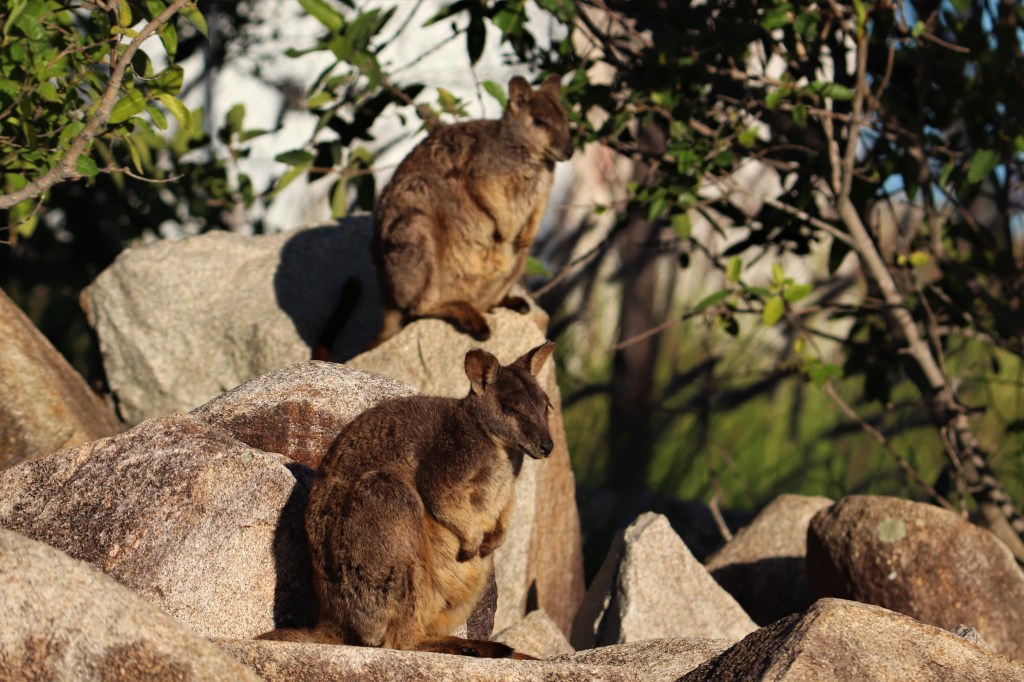
It had been a wonderful Outback Queensland wildlife experience, but my stomach was telling me it was brekkie time, and so I drove into town and picked up a delicious eggs benny wrap and coffee at Perry’s Bakehouse Cafe. This great little cafe is clearly a hit with the locals.
Lissner Park, a surburban park within Charters Towers hosts a roost of Flying-foxes or Fruit Bats, and is only a short walk from the town centre. Even before I reached the park I could hear the screeches and squabbles of the colony. Walking around the park there was a magnificent sight, thousands upon thousands of Black Flying Foxes roosting in the trees.
Black Flying Fox – Lissner Park, Charters Towers.

Closer examination revealed the distictive rufous tinge of a few of the smaller Little Red Flying Foxes, mixed in with the larger population of Black Flying Foxes.
Little Red Flying Fox – Lissner Park.

The tale of the Flying-Foxes at Lissner Park is complicated. There are actually estimated to be 80,000 to 100,000 mammals in the colony. Such large numbers of social mammals make quite the racket for nearby residents. The urine and faeces of the bats also cause problems for humans visitors to the park, and many of the trees in the park have been stripped bare of vegetation.
The trees planted at Lissner Park are mostly introduced ornamental trees, selected no doubt to provide shade for the human population. The Flying-Foxes can hardly be blamed for selecting such lush trees in which to roost in the blistering climate of Outback Queensland.
It must however not be forgotten that Flying-Foxes are incredibly useful long distance pollinators, most important for strengthening native forests against environmental changes. These forests in turn stabilise river systems and water catchments, which of course benefit humans in flood prone regions of Northern Australia.
A few months after my visit I read with great sadness of the dispersal of the Flying-Fox colony at Lissner Park. Methods for dispersal included sustained noise, gas cannons and pyrotechnics, and would have been extremely traumatic for the animals.
The local council hopes the colony will relocate to a new site a few kilometres outside of town. I think the council should consider planting those same trees that are preferred by the colony in Lissner Park if the relocation is to be sucessful long-term, although of course it will take time for these trees to mature.
I would also suggest that with informative signage and visitor infrastructure, these fabulous mammals could make an additional tourist site for the many visitors to Charters Towers interested in wildlife, thus changing the image of the Flying-Fox at Charters Towers from burden to financial benefit for the town.
Porcupine Gorge
Charters Towers had been a great stop off but it was time to head further West. The outlook during the 300 kilometre drive across the vast untamed plains of Outback Queensland to Hughenden alternated between woodland and savannah grassland. The habitat looked promising for the sought-after Spectacled Hare Wallaby.
I arrived at Hughenden around 1pm, where despite being late Winter it was baking hot. I can’t help but admire the hardiness of the people making such remote outback towns their home. I searched the town for a hardware store that stocked gas for my jetboil stove to no avail. Charters Towers would have been a better bet, and Anaconda at Townsville would have been a sure thing, damn.
I was in no rush to reach the campground in the heat of the day and so patronised the local supermarket followed by lunch at the Windmill Inn Cafe. I explained my predicament to the staff regarding the lack of jetboil fuel, and they did an amazing job of cooking up steak sandwiches for evening meals for the next three days, partitioning the salad to avoid soggy bread. Great food, great service would highly recommend!
Porcupine Gorge – Day 1 (Wedge-tailed Eagle.)
Stocked up with provisions, I navigated the final 70 kilometres along the Kennedy Developmental Road to Porcupine Gorge through some wild country indeed. Arriving at the campsite around 2.30pm to set up the tent at the site allocated by Queensland Parks and Wildlife. I was somewhat disappointed to find I had been assigned the most exposed of the 22 sites in the campground, with barely any shade.
The campsite did however have a picnic bench, a sandy square in which to peg out the tent and a firepit. The latter I didn’t use, early evening being of course prime mammal viewing time! The cost of the campsite was ridiculously cheap, only $11 per night to stay in this fabulous and remote location.
There was a short walking trail from the campsite through savannah woodland, to a lookout point on the gorge rim. Excitedly I set off for my first look at Porcupine Gorge. The view at the lookout was breathtaking. Over the precipice was a 25 km gorge 400 foot in depth, testament indeed to the dominant wet season of North Queensland. The famous sandstone pyramid feature of the gorge was shimmering far below in the hazy late afternoon light.
Porcupine Gorge.

Below the gorge rim, high in a corkwood tree was a Wedge-tailed Eagle guarding a nest. It is truly rare to have the height advantage when viewing this apex predator. Porcupine Gorge was already exceeding expectations!
Wedge-tailed Eagle nesting below lookout.

Late afternoon, as is my habit, I drove the spotlighting route to be tackled after dark. Pyramid Road from the campground is 1km to Mount Emu Road, then after a left turn in a Southerly direction for 5km, a cattle grid signals the approach to Kennedy Developmental Road. After a total of 11km the official Porcupine Gorge Lookout is reached, that was even more spectacular than the lookout near the campground.
Map showing the roads spotlighted around Porcupine Gorge Campground
On the return drive the wildlife of the area began to reveal itself. There were Eastern Grey Kangaroos grazing the savannah grassland, and a stately Bustard searching the grass stalks for an insect meal. In a small acacia was a flock of beautifully coloured Northern Rosellas quietly chattering away.
Returning to the campground, I gratefully ate one of the steak sandwiches prepared earlier that day in Hughenden. Then dusk and night arrived in quick succession, before darkness cloaked the campground. Shortly afterwards, a brilliant full moon rose in the Eastern sky.
A full moon was something I had not considered when planning the trip all those months ago, for a bright moon without doubt affects the activity of smaller mammals. Larger mammals less so, but I really hoped this oversight was not going to jeopardize the chances of a Spectacled Hare Wallaby encounter, which after all was the main target.
The evening began with a quick lap of the campground on foot during which I enquired about Bettong sightings with fellow campers. There were Rufous Bettongs doing the rounds but they remained elusive, that would have to wait for another night. Instead I set forth spotlighting the deserted roads by car, at a speed of no more than 15-20kph.
Brushtail Possums were the most common mammal that first evening, with five Possums seen. Possums often emerge from a daytime hollow to sit on a branch before climbing into the canopy to feed. I also recorded two sightings of Rufous Bettong, both of which allowed close approach. A Rascally Rabbit and Wallaroo were added to the tally but the Spectacled Hare Wallaby remained difficult to track down.
Brushtail Possum.
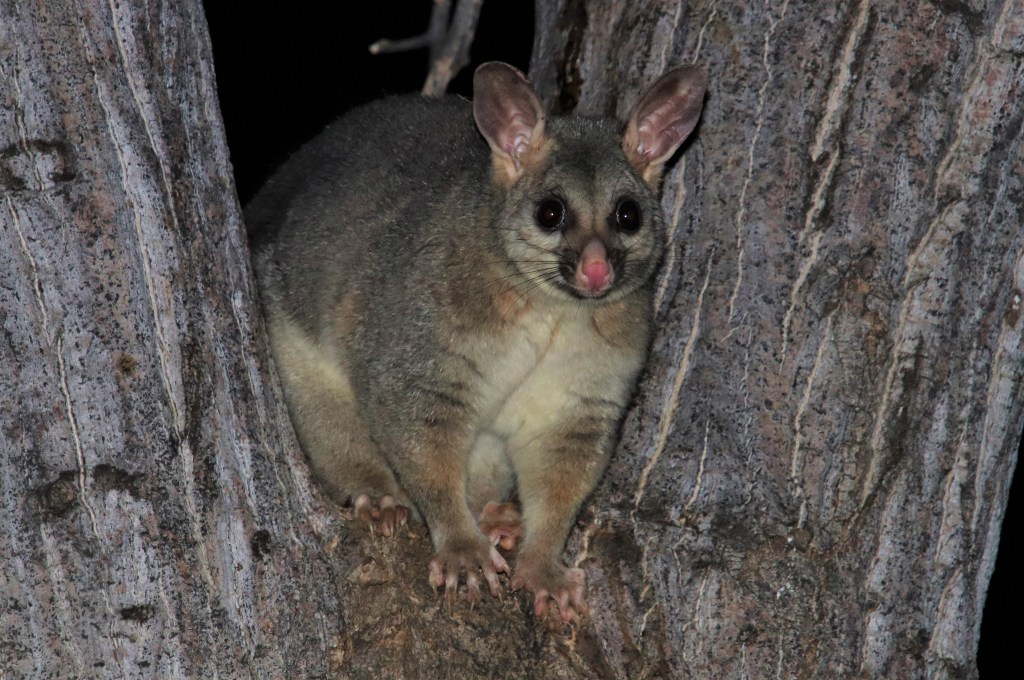
Back at the campground, I was delighted when a Rufous Bettong came to visit. A second drive was planned for later that night for often different species are encountered at different times of a night. It was 10pm when I set forth on that second and final spotlight, tracing the same route.
The 5 kilometre stretch along Mount Emu Road was the most productive for wildlife over the three nights at Porcupine Gorge, and the second drive produced two further Brushtail Possums, another Rufous Bettong and a Tawny Frogmouth attempting to look inconspicuous on a branch.
At 10.30pm, with the car slowly approaching the cattle grid between Mount Emu Road and Kennedy Developmental Road, a sweep of the spotlight from the car window revealed a Bettong-sized mammal. My heart gave a kick as I noticed prominent hip markings that suggested the mammal was something other than a Bettong.
Spectacled Hare Wallaby showing prominent hip markings.

I turned off the car engine and softly approached the animal on foot, all the time hopeful it would remain immobile, and indeed it did. The motionless behaviour in response to danger explains how the Hare Wallabies have suffered so greatly under the jaws of the introduced European Foxes and Cats.
There were once five species of Hare Wallaby in Australia. The Central and Eastern Hare Wallabies disappeared shortly after the arrival the Europeans and their heinous cargo of Foxes and Cats. The populations of Banded Hare Wallaby and Rufous Hare Wallaby were reduced to Bernier and Dorre Islands off the Western Australian Coast, although a small population of Rufous Hare Wallaby also hang on in the Tanami Desert. The Spectacled Hare Wallaby is the only species in relative abundance, because the remaining distribution does not overlap with that of the Fox.
See here for a visit to Dorre Island trapping mammals with DBCA for Rufous and Banded Hare Wallabies:-
Kimberley Wildlife 2020 – Part 1 of 4 – Heading North – Rothschild Rock Wallaby.
Facing the tiny Wallaby I sunk to my haunches and held my breath, for before me was a mystical marsupial known to few Australians, that even fewer have seen. The patches of orange fur around the eyes that give the wallaby their common name were prominent.
Spectacled Hare Wallaby.
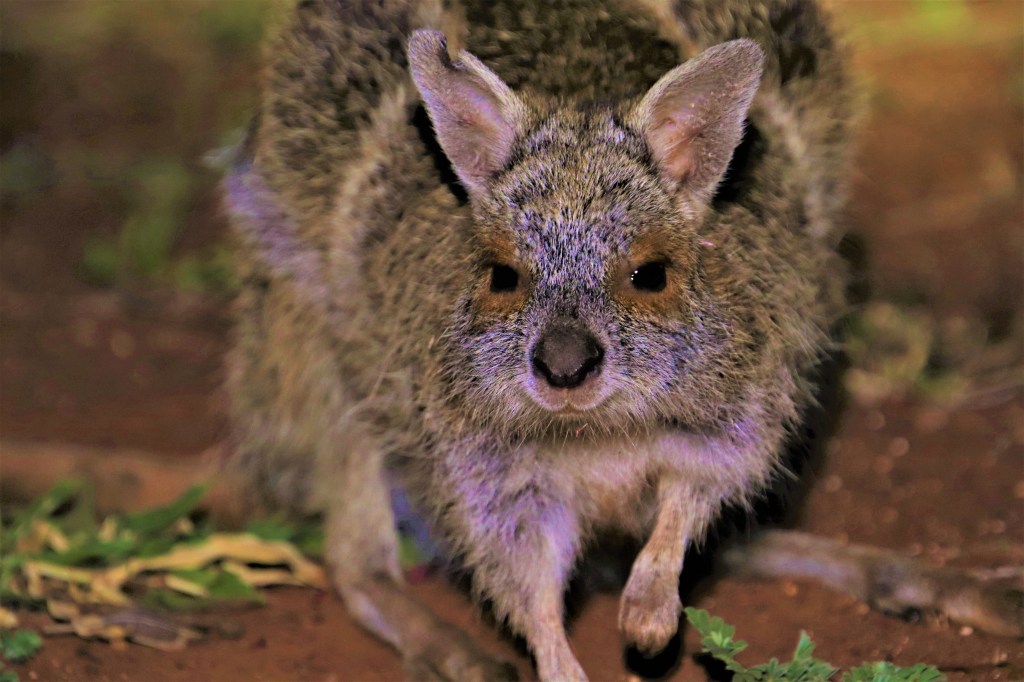
Entering the campground after midnight a few dying embers and snores were the only clues of human habitation. It had been an exhilerating night, but I was exhausted and glad to slide into a sleeping bag to fall asleep under the neverending night sky, while the marsupials of Porcupine Gorge continued their nocturnal activities.
Porcupine Gorge – Day 2 (Spectacled Hare Wallaby)
I woke to the sounds of campers stirring around me and relived the surreal experience of the mammal-filled woodland the previous night. A morning drive to Kennedy Developmental Road saw a mob of grazing Wallaroos immediately outside the campground. These animals were returning to the safety of the gorge after a night on the surrounding grassland.
I enjoyed a complete lack of itinerary for the remainder of the morning, and spent it alternating between reading and staring at the world without hurry. The short walk to the lookout revealed the Wedge-tailed Eagle still guarding the nest, and a large rufous Wallaroo hopping down into the depths of the gorge.
During the afternoon I attempted a short nap, but the lack of shade in the hot tent made snoozing difficult. Frustratingly, at this stage there were numerous empty campsites around me with good cover which remained unoccupied for the following two days. While acknowledging that Queensland Parks and Wildlife provide excellent campgrounds for great value, the site allocation system is a real pain in the ass. I dared not relocate however, in case of the late arrivals to these allocated sites.
As the heat began to mellow mid afternoon, I set off to explore Porcupine Gorge via the 2.4km Pyramid Track, that descends 120m from the campground to the gorge floor. Although the track is steep, the walker is aided by a series of steps and switchbacks.
The rock on the gorge floor is worn smooth by the immense amount of wet-season water, but during my visit it was a lacklustre and lazy creek that idled past. The terminus of the walk is the isolated, pyramid-shaped monolith of multicoloured sandstone,that gives the walking track it’s name. Sitting and enjoying the impressive structure, I considered the fissures and caves at the pyramid base could be excellent Rock Wallaby habitat.
In order to approach the pyramid base, a shallow river crossing was involved. On the opposite bank were a series of rock ledges that involved some scrambling. The final hurdle was a small tributary, before arriving at a jumble of boulders at the cliff base.
Perched on a large boulder I enjoyed the late afternoon birdcall. As the sun sank below the gorge rim, long shadows crept across the ravine. It was after 4pm when I first glimpsed a Rock Wallaby, leaping impressively down almost an almost sheer cliff face. Then shortly afterwards, a second Rock Wallaby emerged from a nearby cave and sat basking only 40m away.
What followed was an amazing experience with a truly wild Rock Wallaby. I watched as it first basked, then when the sun disappeared it began to groom. When a Wedge-tailed Eagle soared far above I feared the magic may have been broken, but the Rock Wallaby froze, relying on excellent camouflage.
Allied Rock Wallaby.

When the light began to fail it was time to make the steep ascent to camp. After dark, I explored the campground on foot, finding a Brushtail Possum and a pair of Rufous Bettong frequenting campsites for a free meal.
The woodland was once again lit by a bright moon as I drove the surrounding roads. Unfortunately the first mammal I saw was a dirty big black feral Cat, at the junction of Pyramid and Mount Emu Roads. The remainder of Mount Emu Road was surprisingly devoid of wildlife until I reached the cattle grid 7km from the campground, at the junction with Kennedy Deveopmental Road. Here I encountered a pair of Spectacled Hare Wallabies, a mother and joey.
Mother and Joey Spectacled Hare Wallaby.

The mother hopped away into the long grass, leaving the dazzled joey on the road. This was my cue to immediately retreat to the car so they could quickly reconcile. At that point a thought occurred to me when I realised this sighting was within a few hundred metres of the observation the previous night. Could it be the Spectacled Hare Wallabies were undertaking a nightly migration from their daytime shelter in the long savannah grass on one side of the cattle grid, to the station on the far side of the grid where they were feeding.
I briefly detoured the Kennedy Developmental Road North of the Mount Emu Road junction, finding another Spectacled Hare Wallaby and Rufous Bettong. It turned into a definite Spectacled Hare Wallaby night when a further three animals were seen later on Mount Emu Road, when returning to the campground. A bright moon it would seem, had no disadvantageous effect viewing this species.
I witnessed first hand how Hare Wallabies acquired their name when approaching the final animal that evening. Instead of freezing or hopping gently off, it bolted off into the night at impressive speed, zig-zagging as it went. The early white settlers obviously thought them comparable to the European Hare with which they were familiar.
Porcupine Gorge – Day 3 (Rufous Bettong)
When the final day broke at Porcupine Gorge Campground, my lack of access to caffeine was becoming a problem. I needed a coffee! Hughenden was the only option and so I drove the 70 kilometres into town. I took the opportunity to fuel up the car before my return drive to Charters Towers that night. It would have been sensible to have returned during the daytime, but I couldn’t counter the urge to spotlight Porcupine Gorge one last time.
During the return journey to Porcupine Gorge I moved an impressive Bearded Dragon from the road where it was basking. Sadly an Eastern Brown Snake had become a victim of vehicle strike on Mount Emu Road.
I did my best to nap in the hot tent that afternoon, knowing I had a long drive back to Charters Towers that night in order to return the hire car to Townsville Airport the following day. This day was the hottest of the three at Porcupine Gorge Campground, resulting in a cover of cirrostratus cloud blanketing the sky. A fiery sunset followed when the cloud was ablaze with a riot of deep red.
Sunset Porcupine Gorge.
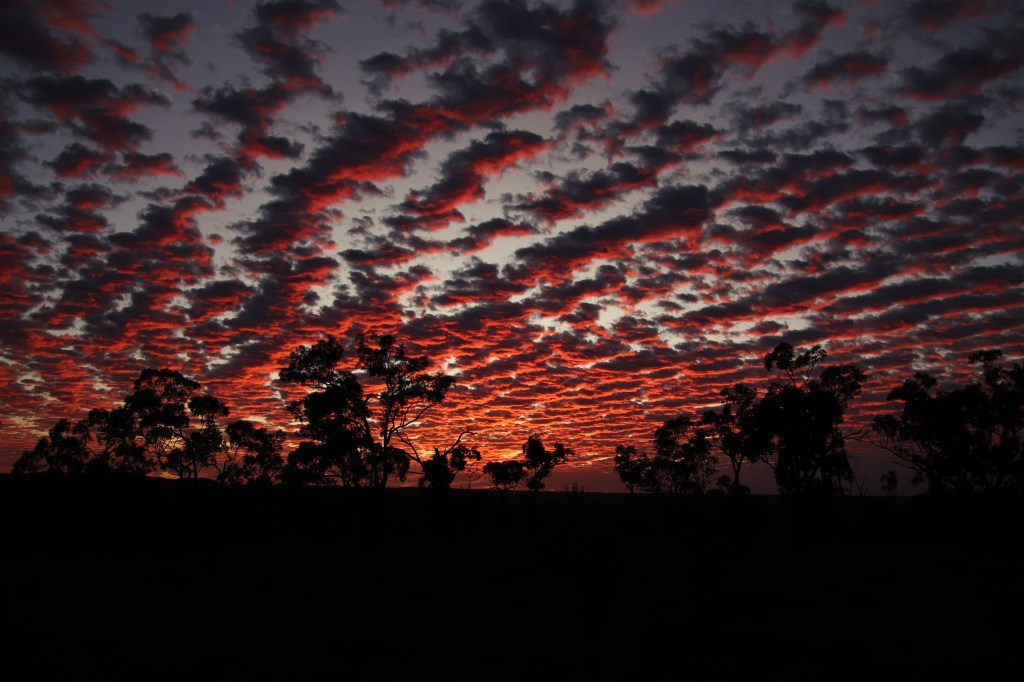
As darkness cloaked the campsite I could hear squeals of delight from a camper nearby, which could only mean one thing. The Rufous Bettong had begun their rounds. The campers were preparing dinner and had attracted the attention of a pair of Bettongs. Sweet potato peelings thrown their way were quickly dispatched, before the funniest thing occurred…..
It was as if the sweet potato peel was an aphrodisiac to the male Bettong who promptly mounted the female and began furiously humping away obviously immodest to the audience. It was quite the performance! I thanked my fellow campers for sharing and returned to my campsite for a final steak sandwich dinner.
I was joined shortly after by the amorous Bettongs These habituated marsupials were obviously campground regulars. They were joined by a second female and for a moment I wondered if there was going to be a menage a trois!
Female Rufous Bettong.

Male Rufous Bettong.

Shortly afterwards, a noisy convoy of 4WD’s made a late entrance to the campground kicking up a trail of dust in their wake. The time was approaching 10pm and I took it as my cue to leave wonderful Porcupine Gorge and return to Charters Towers 300 kilometres away.
There were no Spectacled Hare Wallabies on the final spotlight out of the park, although I did encounter a further Bettong and three Brushtail Possums on Mount Emu Road. Driving the Kennedy Developmental Road to Hughenden, I began to appreciate the folly of a long night drive in this part of Australia when passing mobs of large Eastern Grey Kangaroos.
The Flinders Highway between Charters Towers and Hughenden is a major road train route, and there were sadly large numbers of roadkilled macropods along the highway. I kept my speed between 60km and 80km for the entire trip to both protect my small hire car, but most importantly to avoid adding to the roadkill. It was necessary to make frequent stops to break up the drive.
The night took on a surreal quality on the approach to the small hamlet of Butlers Crossing 41kms West of Charters Towers, when I came across a Spectacled Hare Wallaby sitting in the middle of the road. Judicious use of the brakes, coupled with a respectful speed, ensured this precious marsupial hopped safely away. Sadly on the far side of Butlers Crossing, there was both a Spectacled Hare Wallaby and Rufous Bettong that had not been so lucky.
Around 3am the lights of Charters Towers appeared on the horizon much to my relief. I was exhausted and pulled into a truck bay, where too tired to even get into the sleeping bag I slept in the drivers seat.
Shortly after the bright rays of the sun creeping over the horizon nudged me from sleep. I gathered myself before driving once again upto Towers Hill to enjoy the resident Rock Wallabies for one last time.
Juvenile Allied Rock Wallaby – Towers Hill Lookout.

After coffee and a light breakfast I made the final drive to Townsville Airport, breathing a sigh of relief when I returned an undamaged hire car. It was time to venture even further West, after first relaxing at the check-in lounge prior to the flight to Mount Isa later that afternoon.
Mount Isa
The Qantas regional flight from Townsville to Mount Isa took two hours on a turboprop. My travel companions were an odd mixture of FIFO workers, and tourists eager to explore the vast outback.
As the plane descended into Mount Isa, the mountain ranges cast long shadows across the vast floodplains. The Mount Isa Region contains large deposits of copper, zinc, lead and silver, and accordingly the landscape below was pockmarked with mines.
I had booked the centrally located Barkly Hotel for its proximity to town, and was grateful to find a well-stocked menu at the onsite restaurant. The rooms were small but surprisingly modern. Before dinner, I made the short walk across the road to photograph the Pithead of the Mount Isa Mine, silhouetted against the purples and pinks of the outback sky.
Dusk falls over the Pithead of the Mount Isa Mine.

The purpose of visiting the Mount Isa Region was to find the endemic Purple-necked Rock Wallaby. It occurs at Boojamulla National Park, but another well known site is Lake Moondarra just outside of Mount Isa. This was the back-up plan in the event of a dip at Boojamulla.
It was necessary to hire a 4WD to visit Boojamulla, and so the following morning I presented at Fleetcar Car Hire in town to pick up my pre-booked 4WD. The cost of the hire was $400 per day inclusive of insurance.
www.fleetcrew.com.au/location/mount-isa/
Boojamulla is situated Northwest of Mount Isa, a distance of 340 kilometres by road. The most direct route is West along the Barkly Highway for 118 kilometres, before heading North for 56 kilometres along the signposted Thorntonia – Yelvertoft Rd and onto the Gregory Downs – Camooweal Road. This last road contained many undulations and bends, which in addition to the bulldust, corrugations and rock debris littering the road necessitated a reduced speed of 60 kph in places.
Riversleigh Road into Boojamulla passes the World Heritage Riversleigh Fossil Site. Near the homestead there are three creek crossings in quick succession before the final approach to the campground, through a gap in the Constance Range.
At the campground I noticed the fuel cap was missing from the 4WD. The road had been so rough it had been shaken off during the drive. Mindful that dust in the fuel tank would be a disaster, I covered the inlet with a noodle packet and secured it with an elastic band, bush mechanics in action.
Boojamulla National Park abuts the Northern Territory border, covering an area of almost 3000 square kilometres. The highlight of the park is Lawn Hill Gorge, where the electric blue waters of Lawn Hill Creek and it’s associated green ribbon of rainforest cut a swathe through the savannah of rugged Outback Queensland.
Boojamulla is named from Budjimala (Rainbow Serpent Country.) The rainbow serpent carved the creek so important to the Waanyi people that have inhabited the area for at least 17,000 years.
Boojamulla National Park
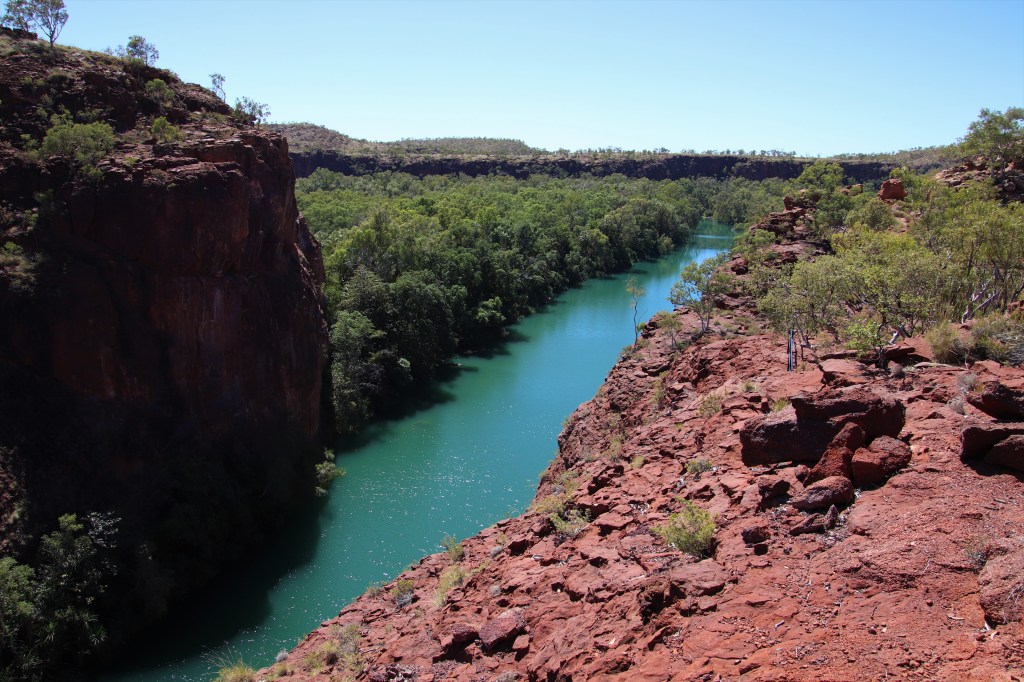
Mid-afternoon I walked the 3.7km Constance Range Track. The track climbs an ancient sandstone ridge to a view point on the Constance Range with expansive views over the surrounding plains. Ring-tailed Dragons were common warming on the sun-heated rocks.
Ring-tailed Dragon.

That evening I visited Island Stack, but in order to arrive there it was necessary to wade across the Lawn Hill Creek and it’s associated sharp rocks, the bridge having been washed away the previous wet season.
The habitat looked promising for Rock Wallabies. However despite quietly staking out the trail passing under the cliff base, there were none to be seen. A different approach was needed, and so I climbed the numerous steps to the top of Island Stack from where I had a birds eye view of the habitat below. The stakeout lasted an hour but the result was the same.
After dinner at the campsite, I decided to thermal image/spotlight along the trails to Indarri Falls. The first part of the trail passes through riverine rainforest where numerous Agile Wallabies were disturbed. The trail then wound away from the water behind Duwadarri Lookout, where a Large-tailed Nightjar and a Wallaroo were seen.
The trail looped around to Indarri Falls. There the hypnotic sound of falling water broke the still of the tropical night. It was magical, and I idled there from some time before climbing the gradual ascent to Duwadarri Lookout.
At the lookout, the thermal imager picked up a fast moving image. When I turned on the headtorch I had great views of a Common Rock Rat as it scarpered among the rocky ledges. There was a very steep descent from the lookout back to the rainforest below on the final approach to the campground.
Early morning I returned once again to Island Stack, but again dipped on Rock Wallabies. It was beginning to look like in order to find the Purple-necked Rock Wallaby I was going to have to search elsewhere, and so I made the call to reduce the planned four nights at Boojamulla to two, and return to Lake Moondarra near Mount Isa for a better chance.
Later that morning I set off to explore past Indjarri Falls to the Upper Gorge Lookout, a distance one way of 3.6kms. The first half of the trail was through savannah, before a gradual climb to the impressive lookout. The return to Indarri Falls was down a steep gorge via a series of switchbacks, and then through the riverine rainforest of Cabbage Palms, Fig trees and Pandanus. This looked excellent habitat for Rock Ringtail Possums that warranted a spotlight that night.
On the approach to Indjarri Falls was an impressive Great Bowerbird Bower, then shortly after I could hear the sound of water tumbling over rocks. I immersed in the delightfully cool waters alongside the Indarri Falls. There are a series of caves in the limestone under the falls, although entering these caves is discouraged on account of a rather cranky Freshwater Crocodile.
Indarri Falls.
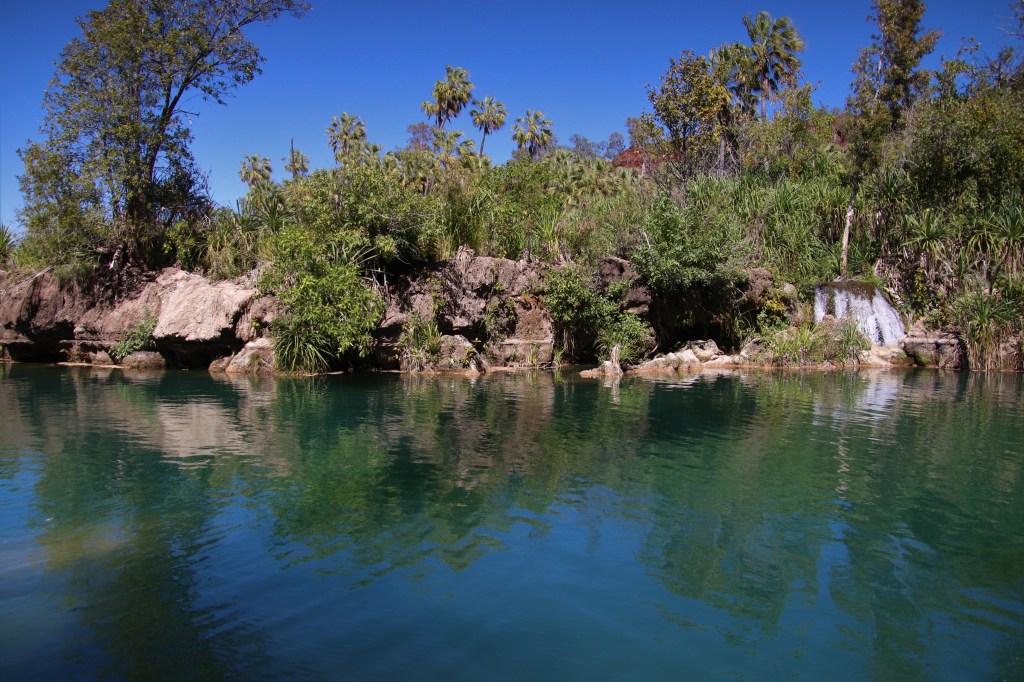
During the afternoon I retreated from the heat of the campsite to the cool shade of the rainforest next to Lawn Hill Creek, where I was joined by a beautiful Buff-sided Robin. This bird of Northern Australia is found in riverine and monsoonal rainforest such as that at Boojamulla, but I have also seen this species on the Mitchell Plateau in the Kimberley Region of WA.
Buff-sided Robin.
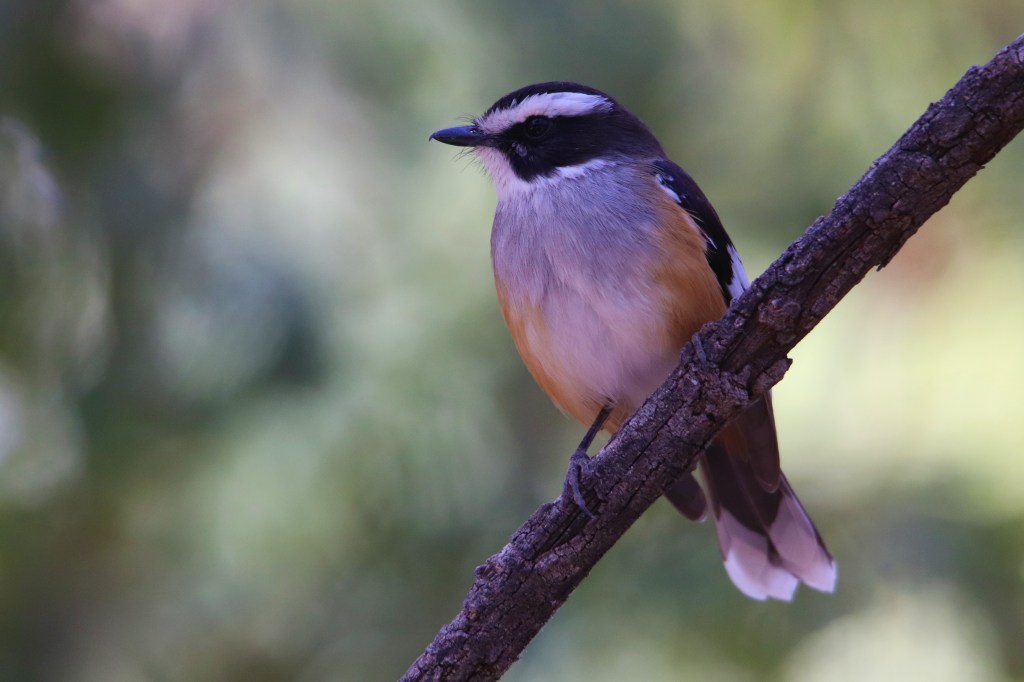
During the time at the creek that afternoon I could hear a pair of Barking Owls calling. Woof-woof, woof-woof, but despite vigourous searching the Owls remained undiscovered. As the afternoon wore on Agile Wallabies appeared in the area adjacent to the creek.
Agile Wallaby.

The final visit to Island Stack was once again bereft of Rock Wallabies, but late that night I finally had success with the species when I spotlighted two Rock Wallabies on the large rock ledge South of Indarri Falls. I followed the track through the rainforest towards Upper Gorge Lookout but the Rock Ringtails didn’t materialise, neither in fact did any other wildlife, validating the earlier decision to leave Boojamulla.
The following morning when breaking camp, I noticed one of the rear tyres on the 4WD was halfway flat. Close examination revealed nothing in the way of an obvious puncture, and so I made the short 15 kilometre journey to nearby Adels Grove Campground where I hoped an air hose might temporarily solve the problem. There was no air hose and so I changed the spare and considered my options.
The Gregory Downs- Camooweal Road on the journey into Boojamulla was extremely rough, but there was an alternative route back to Mount Isa. This longer route is via Gregory Downs, Burke and Wills Roadhouse and Cloncurry, and while it was 200km further, the road was reputed to be better with much of it sealed. Besides, I had read reports of Rock Wallabies at Chinaman Creek Dam just outside the township of Cloncurry. The decision was made.
The first part of the trip to Cloncurry travelled unsealed roads as far as Gregory Downs. This road was in much better condition than the Camooweal – Gregory Downs Road, although the bulldust was decidedly worse. I passed a roadkilled Rock Wallaby in the middle of a floodplain and far away from any Rocky escarpment, testament to the lack of Foxes. This could have been one of two species, for it is not only the Purple-necked Rock Wallaby that occurs here but also the Wilkins Rock Wallaby at the Eastern end of it’s distribution.
Cloncurry and Chinaman Dam
After a long day on the road, the car hobbled into Cloncurry where a beeline was made for the excellent Cloncurry Tyres and Batteries. The flat tyre was assessed and the conclusion was dust had invaded the tyre beading resulting in the slow puncture. It was a prompt and easy fix for a great price. I highly recommend this excellent small business if in the area and requiring assistance.
Less easy was finding accomodation in town last minute, there seemed to be no rooms available anywhere. Ultimately, two nights were secured at the rustic Post Office Hotel. This was not the town’s highest establishment, but staff were super friendly and the beer cold, both a great bonus when staying in Outback Queensland.
Late afternoon I visited Chinaman Creek Dam five kilometres West of town. As the sealed road descends to the picnic area and boat ramp, there is an obvious ridge of rocky outcrops on the right hand side that looked worth exploring. As soon as I climbed from the picnic area, a Purple-necked Rock Wallaby was flushed up onto the rocky ridge.
Things were finally looking good for daytime viewing of this species. I walked to the highest rocky outcrop and sat down to take in the panoramic view of Chinaman Creek Dam far below. On the opposite bank of the dam is the rocky outcrop I climbed on the final morning.
Chinaman Creek Dam.

While enjoying the superlative views from the ridge, the Purple-necked Rock Wallabies slowly began to reveal themselves. A Rock Wallaby positioned itself on a boulder below to groom, one of five Wallabies seen over the course of the late afternoon.
Purple-necked Rock Wallaby.
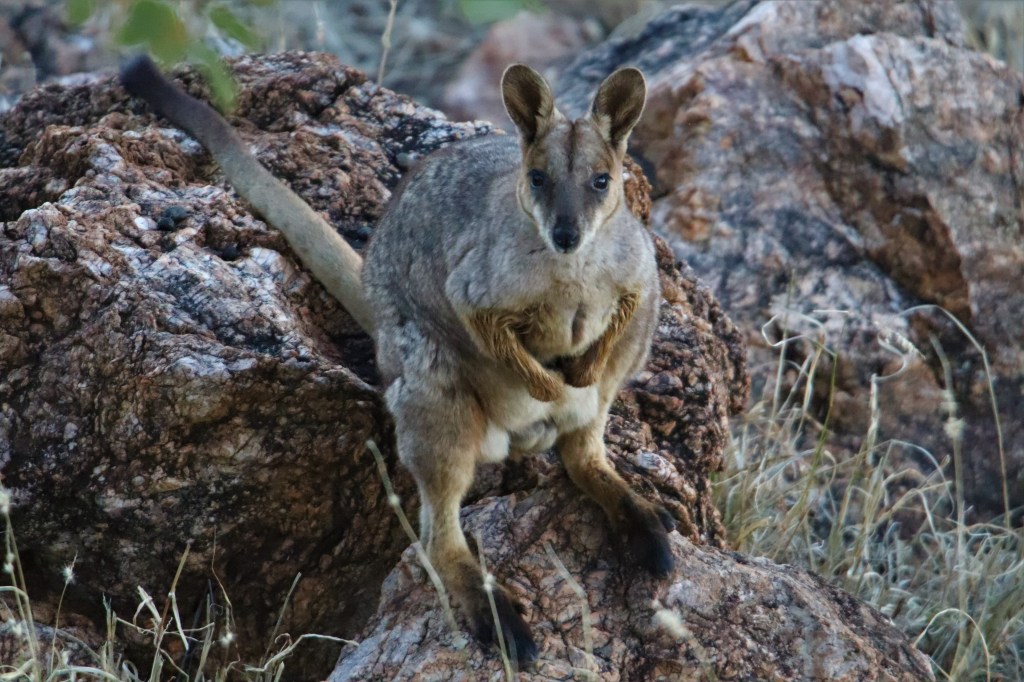
The following day, I spent both early morning and late afternoon at Chinaman Creek Dam to coincide with the period of activity of the Rock Wallabies. My attention was concentrated on the rocky outcrop at the far side of the dam. I was sure that this excellent habitat would contain high numbers of Rock Wallabies.
The most direct route to the outcrop was across a road below the dam wall that forded the creek. There were surprisngly no depth indicators, and this was saltwater croc country so to assess the water depth on foot wasn’t an option.
I was fortunate that evening to encounter a couple of local boys sculling beer at the picnic area. They assured the water over the road beneath the dam would come no higher than the 4WD sidesteps. This was the confirmation needed, and so a plan was hatched to brave the creek the following morning at first light.
As I was preparing the leave the dam, a gigantic flock of corellas wheeled and circled in the multicoloured sky above, seemingly undecided on a roost to settle for the night.
Corellas at Dusk.

On the final morning in Outback Queensland as the rest of Cloncurry slept, I made a last visit to Chinaman Creek Dam. It was an eerie experience fording the road below the dam wall in complete darkness, and I was relieved the information provided by the drunk youths the previous evening was accurate regarding the water depth.
I parked the car at the base of the bluff and slowly ascended the steep 45 degree climb. Behind the East of the sky was glowing a deep orange, illuminating the crags and ledges of the mountain. I flushed increasing numbers of Rock Wallabies as I climbed ever steeper. Stopping to catch my breath, there Rock Wallabies were peering down from ledges on the rock faces. The distinctive purple neck colouration obvious on some animals.
Purple-necked Rock Wallaby.

The climb had been hard work, but fortunately there were flat boulders at the summit and so I sat down cross-legged and took in the stupendous view. Spread out below was the azure waters of Chinaman Creek Dam in the foreground, behind the ancient weather-worn mountain ranges of Outback Queensland bathed in the crisp early morning light. Nearby in a tree, a Djiti-djiti (Willie Wagtail) vigourously chirruped away. It was absolutely perfect.
Outback Queensland.
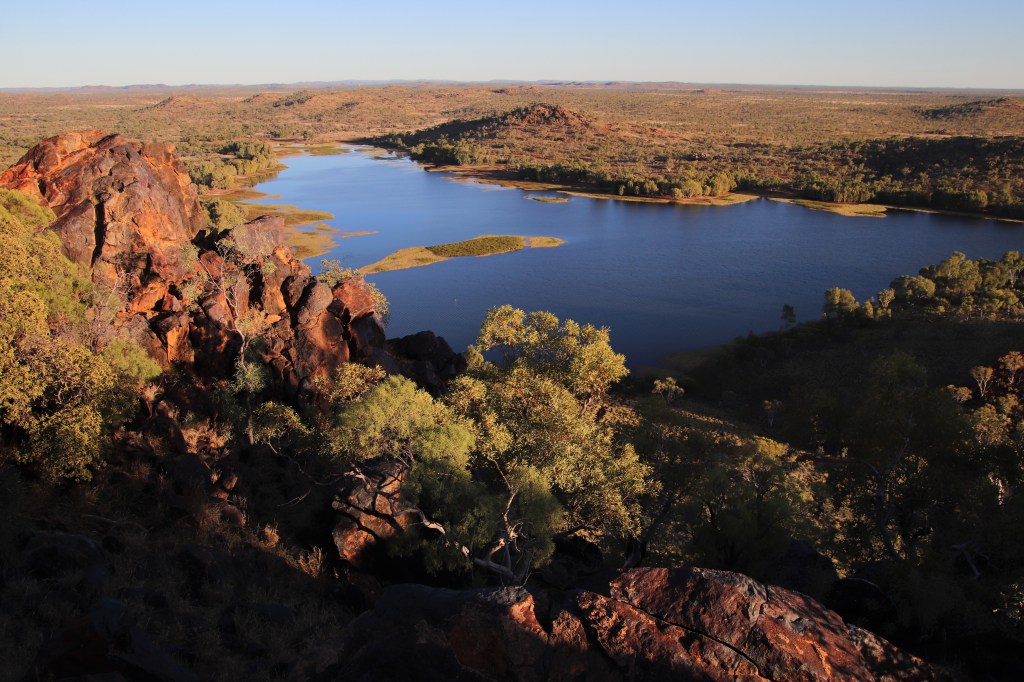
I sat there transfixed for what seemed like an eternity. Eventually the realisation I had a 100 kilometre drive back to Mount Isa sank in, and I reluctantly returned to the 4WD far below.
Descending a different route, I lost my way and found myself on a precipice with sky all around. Below was a face peering up at me, a Purple-necked Rock Wallaby, the colours graphic against the dark rock.
Purple-necked Rock Wallaby.

On that one early morning visit to the outcrop, I encountered an astounding twenty Purple-necked Rock Wallabies. It was a serendipitous find, only discovered after the flat tyre at Boojamulla.
I returned to Mount Isa, then the following day flew to Townsville. My life partner Lorenz, had flown in via Brisbane and we excitedly visited a part of Australia we had never before explored for wildlife – Magnetic Island. After Magnetic Island, I continued solo to visit the best site in Australia for mammals (big call,) the enchanting Atherton Tablelands.
The Atherton Tablelands always delivers in spades, and this short visit was no different. The highlight being a mammal predation by an Owl that was was both awesome and awful.
Continued in Northern Australia – Part 4 – Wildlife of Tropical North Queensland…..
#QuollingAround
Way better to see the animals in the wild but Caversham will have to do for now! Took some overseas visitors there yesterday, they loved seeing our Aussie wildlife!
LikeLike
Hey Anna, I visited Caversham Wildlife Park a few years ago and it was excellent! I’m sure your overseas visitors were grateful for a close up experience with our native mammals. Wildlife parks are an important part of our wildlife conservation. I think they run a nocturnal spotlighting tour where the visitor can see Woylies and Quenda, I’ve been meaning to do it for years and you’ve inspired me! Jimmy
LikeLiked by 1 person
Oh the visitors loved it! The park was fantastic, we pretty much saw every animal! Such a variety of our beautiful native animals. You’ll definitely have to go back!
LikeLike
Absolutely love your posts, you are doing an amazing work and always check before I embark on any trip
Javier
LikeLike
Thanks for the feedback Jose. I truly hope the blog has provided useful information on your trips. Kind regards Jimmy
LikeLike